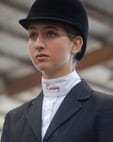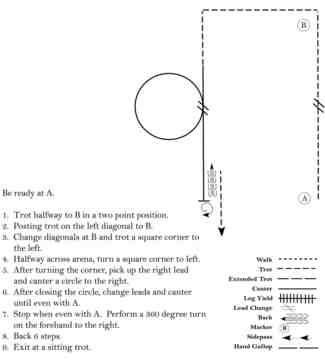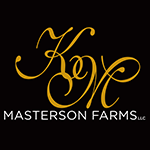AQHA judge, GoHorseShow.com reporter, and 18-time All-American Quarter Horse Congress winner, Laura Gilmer discusses some of the important parts of the Congress showmanship, horsemanship, and equitation patterns. Last up in the series: Breaking Down the Congress Patterns: Equitation.
This article will concentrate on the Amateur and 15-18 patterns since they are the most difficult (and the same) and have several of the same maneuvers as the lower divisions. Trotting square corners seem to be very popular this year and shows up in the showmanship and equitation patterns. In the horsemanship, jogging to an extended trot, extended lope to a slow lope, and extended lope to a stop are common maneuvers in the many of the patterns.
Hunt Seat Equitation
The biggest advice I can give any competitors in the Hunt Seat Equitation is to have direct contact with their horse’s mouth–do not have slack in your reins and ride your horse FORWARD. This class is an English discipline, and the individuals that ride it like they are in a western pleasure class are not going to win a prize at the Congress. The horse needs to be ridden forward in a hunter pace that is maintained through the entire pattern and on the rail.
 At the Congress, an exhibitor, especially in the regular division classes, should know their diagonals. It is considered a major fault, and a competitor who misses their diagonal or looks down should not expect to win or place at this level of competition. Also, some riders tend to get hesitant and are more afraid of making mistakes than riding to win, especially older competitors who are expected to do well. The pressure gets to the rider causing them to mentally hold back resulting in them not performing at the highest level. So, from personal experience, GO FOR IT, don’t be afraid to ride in an aggressive confident manner and show the judges you are here to win. When you get older and look back at your experiences showing at the larger shows, you will know that you tried your best and went all out on your patterns, even if you end up making a mistake
At the Congress, an exhibitor, especially in the regular division classes, should know their diagonals. It is considered a major fault, and a competitor who misses their diagonal or looks down should not expect to win or place at this level of competition. Also, some riders tend to get hesitant and are more afraid of making mistakes than riding to win, especially older competitors who are expected to do well. The pressure gets to the rider causing them to mentally hold back resulting in them not performing at the highest level. So, from personal experience, GO FOR IT, don’t be afraid to ride in an aggressive confident manner and show the judges you are here to win. When you get older and look back at your experiences showing at the larger shows, you will know that you tried your best and went all out on your patterns, even if you end up making a mistake
 For the 15-18/Amateur Equitation pattern, the riders are asked to be ready at cone A to start the pattern.
For the 15-18/Amateur Equitation pattern, the riders are asked to be ready at cone A to start the pattern.
1) They start the pattern at a trot in two-point position, in a straight line. According to AQHYA World Champion Carey Nowacek, this will be the defining part of this pattern. “It will be difficult to start from a stand still, and trot straight into a two-point. This element will really show the strength of the rider. Half way between cone A and B, we are asked to come down to a posting trot on the left diagonal, this will feel like the incorrect diagonal if the pattern is set anywhere near the rail.”
I agree with Carey’s assessment of the two point position that starts at the beginning of the pattern. This maneuver will definitely weed out the weaker riders. The rider must have excellent balance and strong legs to be able to complete that part of the pattern. The key to this pattern as well is to be able to maintain the same pace throughout the pattern–if the rider is unable to maintain the same pace-it tells me they have a lack of balance and they have not developed strong enough legs and have not practiced enough to be at the top of their game.
2) Also, to have to pick up the left diagonal out of the two point position may also be disconcerting to some because you are having to pick up your diagonal from a raised position rather than the normal sitting position. The rider needs to maintain their pace through the corners and when they pick up diagonals.
3) At B, the rider change diagonals and execute a square corner to the left. After the first corner, they continue straight across the arena. Again, the rider needs to maintain the same pace throughout and when they are switching diagonals.
4) Halfway across the arena, the riders are asked to show another square corner to the left. Again, both corners are a very difficult piece to make pretty without being too sharp or tough, making it look too hard and forced. Try to maintain the same pace throughout.
5) After the second left corner, they pick up the right lead and canter a circle to the right. After having your horse shaped to the left for a left corner, it will be a challenge to have a good right lead departure, the rider has to make sure he/she gives their horse enough time to straighten out after the corner, or they run the risk of maybe picking up the incorrect lead, or just having an ugly departure. Through the right circle, the exhibitor can get reconnected with their horse if at anytime they have lost connection, and make a pretty, collected circle.
6) Towards the end of the circle, the collection will be a key part, because at the close of the right circle, the rider is asked to change leads and continue cantering until even with cone A. The rider must have their horse under control to make a smooth lead change at the exact spot indicated in the pattern.
7-9) Here’s the part where we get to give our judges one final look, Nowacek says. “A straight line to a stop–you have to remember to make sure you are sitting tall and confident through the whole piece. When stopped, we then execute a 360 degree turn to the right on the forehand, back six steps, and exit at a sitting trot,” she said. “The turn to back has to look easy, and effective all at the same time keeping a perfect body position. And again, leaving at the sitting trot, bust that out and NEVER quit showing.”
 Valerie Fites Sturgeon also adds, ” I think it’s very important to show how your horse can move off your legs but stay flowing through out the turn. Another important key point is to make sure you keep the last cone in the corner of you eye when you are ending your pattern (cone will be across from you). The pattern on paper sounds like it’s going to be using a large portion of the arena (halfway across the arena) and should be well suited for a true hunter.”
Valerie Fites Sturgeon also adds, ” I think it’s very important to show how your horse can move off your legs but stay flowing through out the turn. Another important key point is to make sure you keep the last cone in the corner of you eye when you are ending your pattern (cone will be across from you). The pattern on paper sounds like it’s going to be using a large portion of the arena (halfway across the arena) and should be well suited for a true hunter.”
In conclusion, I believe the rider that sets the most appropriate consistent pace and maintains it throughout the patterns, gets all their diagonals, shows a strong two-point position, and maintains contact and direct communication with their horse will have a big advantage and will score high on my judge’s card.
Click below to see Breaking Down the Congress Patterns: Horsemanship and Showmanship.









